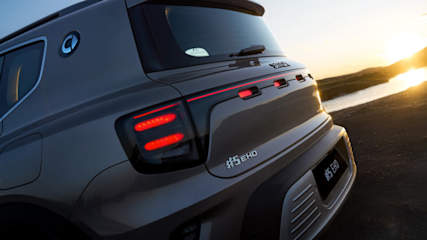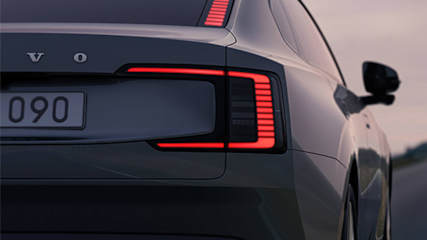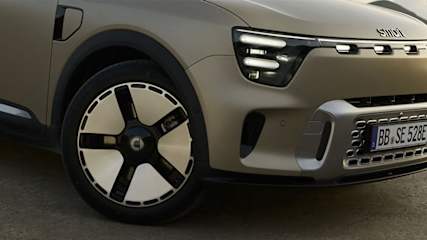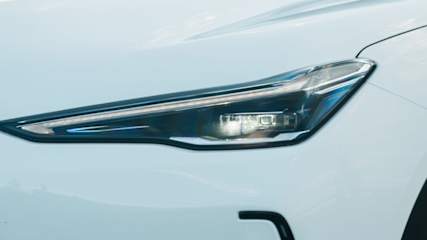Smart News
.jpg)
What brand does this badge belong to?
Read the article
By Laura Berry · 18 Dec 2025
Feel like there’s suddenly a whole lot of new car brands with logos you don’t even recognise.
.jpg)
Tiny car legend looks set to return
Read the article
By Tom White · 16 Dec 2025
Smart is poised to return to its roots with an ultra-compact city car, according to new spy images.Smart's fifth model since its Mercedes-Benz and Geely re-boot, the #2 has already been teased in Chinese social media as the ForTwo’s successor, but new ‘spy pictures’ shared via the brand’s official channels confirm it will even follow the original Smart car’s aesthetic and proportions.Built on a new platform dubbed ECA (Electric Compact Architecture), and equipped with just two doors, the #2’s design will be be led by the Mercedes-Benz design team. Smart confirmed the car would be built in China and is targeting global export markets.Specifically, the brand teased the #2 at the Munich motor show, with a European release slated for 2027.Due to its ultra-compact dimensions, Chinese media is speculating a battery size of roughly 30kWh, equivalent to other ultra-compact vehicles sold in Australia like the BYD Atto 1 (From $23,990, 30kWh, 220km range) or Hyundai Inster (From $39,000, 42kWh, 327km range).Smart’s reboot looks to continue full steam in Australia, with the brand following up on the #1 crossover and #3 small SUV with the recently-revealed-in-Australia #5 mid-sizer, which is likely to be the first Smart offered in Australia as a plug-in hybrid.It is unclear whether Australia will see the recently-revealed #6 sedan, which looks to be a hybrid-first proposition equipped with a 1.5-litre plug-in hybrid drivetrain.The two-seat #2 which returns the brand to its low-cost and ultra-compact origins may be a perfect fit for markets like China, Japan, Korea and Thailand, but it is unclear whether the brand will take another shot at the poorly-served city car segment in Australia.Generally, cars with ultra-compact dimensions are difficult to comply with Australia’s stringent design laws, and many brands often don’t want to roll the dice with such a car receiving a sub-five-star ANCAP safety rating.However, the segment has again received more interest locally, as brands look to exploit an under-served space that's well suited to electric vehicles. BYD’s Atto 1 recently bucked the trend of associating low safety with ultra-compact vehicles, scoring a maximum five-star ANCAP safety rating.BYD’s affordable offering is yet to put its first runs on the board, but Hyundai’s more expensive Inster has thus far chalked up 426 registrations in Australia. Meanwhile, Smart is not a member of the FCAI and its sales numbers do not appear in the VFACTs industry report.The original Smart ForTwo was sold in Australia between 2004 and 2007 equipped with a 1.0-litre three-cylinder engine. Its line-up expanded over time to include the ForFour hatch and even a roadster model.

This new hybrid has nearly 2000km of range
Read the article
By Jack Quick · 08 Dec 2025
Double-size hybrid Smart can travel nearly 2000km on a single tank of fuel and a full battery.

Highly awaited SUV goes hybrid!
Read the article
By Tom White · 28 Oct 2025
Subaru Forester-rivalling Smart goes hybrid

New cars that would make their founders roll (or LOL) in their graves (probably) | Opinion
Read the article
By Byron Mathioudakis · 28 Sep 2025
Prompted by this week’s announcement of an MG ute, here are some of today’s most egregious examples of new cars or latest models that might have their founders confounded, dazed or confused.
And before firing off missives our way, we are not judging any of the listed vehicles’ merits; indeed, we admire their makers’ gumption and self-belief. Good for them!

The cars Australians are 'hungry for': 2025 Sydney International EV motor show returns with models from Smart, Volvo, XPeng and Zeekr as EV sales are predicted to boom
Read the article
By Dom Tripolone · 12 Sep 2025
Motor shows are officially back in Australia, and it's all because of electric cars.The Sydney International EV motor show is returning this October to the ICC Sydney, proving the EV show wasn’t just a flash in the pan.The organiser of the show, Ray Evans, said they are expecting about 40,000 visitors to come through the gates over three days.“The exceptional response has proven that Australians are hungry for EV knowledge and options," said Evans."This year we're delivering exactly what the market wants - hands-on experiences with over 100 vehicles, test drives, daily sessions and a New Model Stage.”The show will give potential customers a chance to get up close and personal with some of the newest names in the EV game.Brands such as Farizon, Lotus, Polestar, Smart, Volvo, XPeng and Zeekr will have current and coming models on display.Volvo Australia boss Stephen Connor said the company is committed to a fully electric future."This year we have already introduced three new all-electric models to Australia, and to date our all-electric lineup equates to 40 per cent of our total volume," said Connor.Volvo will have the new ES90 electric sedan on display at the show. Attendees can also check out the $1.2m Rolls-Royce Spectre EV.Some experts have predicted Australian EV sales to balloon to between 15 and 19 per cent next year, according to the show organisers. Currently EV sales only make up about 7.7 per cent of new car sales through the first eight months of this year.The show runs from October 31 to November 2nd and tickets start from $35.00 and are available now from Ticketmaster.

How big?! New rival to the 2026 BYD Sealion 7, Tesla Model Y, XPeng G6 and Zeekr 7X takes shape as Smart's largest car yet has been confirmed for sale in Australia
Read the article
By Jack Quick · 10 Jul 2025
Smart relaunched in Australia last year with two electric SUV offerings and it’s soon set to introduce a third which will be the brand’s biggest car yet.The Smart #5 was globally unveiled in Australia last August and it has now been approved for local sale.According to local government approval documents, it reveals the #5 has been approved for sale in a total of six different trim levels. These include Pro, Pro+, Premium+, Pulse+, Edition and Brabus.At this stage it’s unclear if all of these variants will be offered locally.The entry-level Pro variant is powered by a single 250kW electric motor, the Pro+ and Premium+ are powered by a single 267kW electric motor, the Pulse+ and Edition feature dual electric motors with a total system output of 432kW, and the flagship Brabus has a dual-electric motor setup with a total system output of 475kW.The approval documents don’t reveal what battery pack the #5 will have locally, though globally it’s offered with either a 75kWh or 100kWh battery pack. The latter offers up to 740km of range, according to lenient CLTC testing.Other information revealed in the approval documents include the tare mass varies between 2200kg and 2378kg, depending on the trim level. Braked towing capacity is 1600kg across the range and unbraked towing capacity is 750kg.Depending on the trim, the #5 comes with 19-, 20- or 21-inch alloy wheels.This car measures in at 4695mm long, 1920mm wide and 1705mm tall with a 2900mm wheelbase. This is around the same size as a Tesla Model Y.According to Smart, there are 34 storage compartments in the car, as well as up to 1530L of boot space and a 72L frunk.At this stage Smart hasn’t disclosed standard specifications for the local #5 line-up.Globally there is a 10.3-inch digital instrument cluster, two 13-inch touchscreens and a 25.6-inch head-up display, interior ambient lighting and a 20-speaker Sennheiser sound system available.When the #5 was revealed last year it was earmarked for a local launch around mid-2025. It's now set to arrive either in late 2025 or early 2026.

Save thousands with these new car deals: All the end of financial year deals from car brands in Australia
Read the article
By Jack Quick · 01 Jun 2025
It’s EOFY time again!
.jpg)
All the Chinese car brands in Australia and their models
Read the article
By Jack Quick · 27 May 2025
There are more and more Chinese car brands entering the Australian new car market seemingly every day.

Is brand loyalty a thing of the past in the Australian new vehicle market? Why the new wave of challenger brands like MG, BYD and GWM will detach an increasing number of buyers from their long-term favourites | Opinion
Read the article
By James Cleary · 27 Apr 2025
In 2025 branding means way more than a hot iron mark scorched into a steer’s backside.It’s about a brand’s personality, reputation and your interactions with it. What it says about you. What it delivers. How it makes you feel. A visual identity, a design style… and a million other things. And there are automotive brands in the Australian new-car market that have strategically built solid brand equity over many decades.Current market leader, Toyota began dipping its corporate toe into global export waters by shipping cars here in the late 1950s. And other Japanese makers like Honda, Mazda and Nissan followed it in conquering initial hesitancy by steadily investing in strong retail networks, pushing product improvement and focusing on a positive customer experience.Ford has built its global brand around everything from the Model T and its revolutionary assembly line to pumped up muscle cars and victory at Le Mans. While here it embedded itself in the local landscape via a manufacturing presence spanning close to a century and regular victory at Mount Panorama.And more recently, relative newcomers like Hyundai and Kia have moved rapidly from cheap and (mostly) cheerful to innovators that repositioned the concept of value and quality in the local market.All of which led to large pockets of ‘rusted on’ brand loyalty. The concept of ‘Ford and Holden families’ started to diminish from the moment the latter departed the scene in 2020 (if not before), but Toyota’s reputation for value, durability and affordable ownership has seen it maintain a legion of never-say-die fans.Same for Ford, Mazda, Mitsubishi and others. But I'd argue a turning point was when, after an initial false start through a private importer in 2013, MG set up as a direct subsidiary in 2017.Great Wall had landed as the first Chinese car brand in the Aussie market in 2009, but MG 2.0 was different. Even if its ‘Since 1924’ positioning stretched credulity, its products were better than expected and pricing was ultra sharp.Sharp enough to encourage budget-focused new-car buyers, even used-car prospects, to give the brand a go.With the introduction of new-generation products in the early 2020s sales took off like a rocket, and it’s here that my ‘That’s a good idea’ theory kicks in.I reckon executives at rival Chinese car brands, keeping an eye on MG’s increasing success Down Under, all had the same ‘good idea’ at the same time. Namely, let’s get into Australia and grab a piece of that action. Hence the subsequent arrival of Chery in 2023, itself a factory-backed restart after an initial import-distribution arrangement broke down back in 2011. Followed by the flood gates opening, with BYD, Deepal, Geely, a ramped up GWM, JAC, LDV, Leapmotor, Smart, Jaecoo, XPeng and Zeekr all jumping in with Aion, Avatar, Jetour, Lynk & Co, Skyworth and others waiting in the wings.Doesn’t matter which category you’re talking about - white goods, sporting equipment, hi-fi - if one fresh competitor enters a mature market, it’s likely to be met with reluctance, even contempt by existing brand loyalists.But if near enough to 20 newcomers blaze into market at the same time, clearly something seismic is going on and it feels like you’d be missing a trick if you didn’t at least investigate the rapidly changing competitive landscape.Give them the benefit of 20/20 hindsight as well as a time machine and it’s not certain all the new brands above would currently be making an Aussie entrance.But multiple triggers have been pulled with retail network deals done, head office staff recruited, parts warehousing set up, service and sales training completed and marketing campaigns launched. So, in a mature market, early movers like MG, Chery and GWM have the advantage and more recent arrivals will need to find a way to win over buyers… fast. And it’s a fair bet the ever-impactful lever marked price will be pulled on a regular basis.Some of the newcomers as well as more than a few existing legacy brands will be forced into a price war. Like it or not, loyalty comes under pressure when the incentive is enticing enough and with a cut-price cage fight likely to take place sooner rather than later not everyone will leave the octagon alive.Stand by for new-car buyers tempted en masse into ‘unbeatable deals’ that mean brand loyalties will be stretched beyond breaking point. The shake out from this looming war of attrition will be huge.





